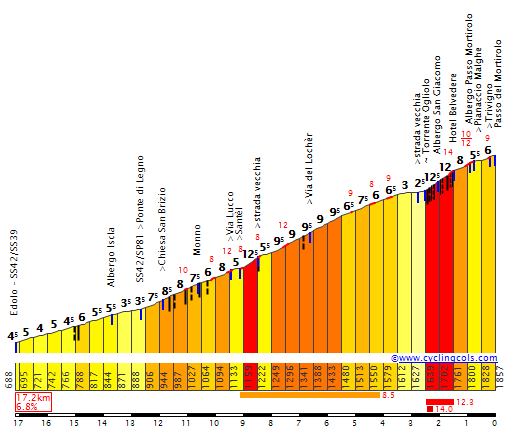
Thanks to @Devil's Elbow I got to copy a post almost as long as this stage:
Stage 15: Manerba del Garda – Livigno (Mottolino), 222.0k
The queen stage, and it’s a great microcosm of all that’s wrong with RCS. Sure, the numbers make it seem really hard – longest stage of the race, 5400 metres of elevation gain – but the terrain just isn’t all that suitable for attacking. And it’s entirely RCS’s own fault: for the second year running, they’ve announced a big climb in Switzerland that is usually closed in May, done nothing to ensure the road is actually open, and then – surprise! – had to change plans after the original announcement. To do so once is bad enough, to do so twice in a row means you’re either totally incompetent or serially dishonest. Now, they could still have had a stage that was almost as good as the original one by going over the Gavia (which backs directly into the penultimate climb) instead of the weak side of the Mortirolo, but clearly that was too much to ask for too. The result is this mess of a stage, the weakest route with over 5000 metres of elevation imaginable.
The route


The caravan has transferred all of 15 kilometres overnight, into Manerba del Garda. Modern Manerba is a collection of small villages joined together by new, mostly tourist-oriented sprawl. Above it is a rocky hill that was inhabited from the Mesolithic until the Middle Ages, today both an archeological site and a popular viewpoint.

The route starts by bypassing Salò – clearly, Riccione was enough in the way of uncomfortable fascist history for one Giro – and then heads up the Chiese valley, away from Lake Garda. Here, we pass through Sabbio Chiese, where last year’s Monte Bondone stage started. At the point where the valley turns northeast towards the Lago d’Idro and Trentino, the riders leave it, and that means it’s time to climb. Lodrino isn’t exactly hard, but if the break hasn’t gone yet, the racing will be.

Next up is the first Alpine pass of this year’s race, Colle di San Zeno. This is the shorter, easier side, but it’s still a good climb. If there is still no break, it should form here.

The descent is probably the narrowest of this year’s Giro and takes us to the northern end of Lake Iseo. It’s only a quick visit, as the route heads north up the Val Camonica. This valley section lasts for quite a while, taking us through the intermediate sprint to the Mortirolo. Infuriatingly, this will be the third time in its four most recent inclusions that they’re taking the single easiest way up, and while I’m fully aware that the classic side can’t be easily reached from this direction, they could at least acknowledge the existence of the Recta Contador.

The descent into the Valtellina is fairly technical (you may remember Nibali attacking here in 2022). The road up the valley is a long drag, but at 32 kilometres from the line, the climbing restarts in earnest. With that, the flat has ran out, but the actually steep stuff very nearly has as well by this point. Some of what remains comes on the short climb to the bonus sprint at Le Motte.

After the briefest of descents and the Intergiro sprint, it’s time for Passo di Foscagno. It’s at altitude and at least somewhat long, but an average gradient of 6.5% on a very consistent climb isn’t exactly great for attacks.

A brief descent takes us to the bottom of the most hilariously overcategorised climb in history, Mottolino. Forget about ASO thinking Arcalis should be a HC climb, here’s RCS designating a 4.7k, 7.7% MTF as a cat. 1 in a race without a HC category. All the difficulty is in the final two kilometres.


The Mottolino MTF is new to the Giro, the final ramp having been paved for this stage, but the resort village of Livigno to which it belongs has hosted twice before, in 1972 (Eddy Merckx) and 2005 (Iván Ramiro Parra, on a Mythical Mark Padun weekend before Mythical Mark Padun was a thing). In the latter year, it also hosted the MTB world championships. Away from cycling, it’s a high-altitude ski resort that has enjoyed duty-free status since its days under Austrian control.
What to expect?
A war of attrition in the GC battle (unless Pogacar feels like dropping a watts bomb, I guess), whether that happens behind a breakaway or not is up in the air.
This stage will be more exhausting for the viewers than for Pogačar.
Last edited:
















